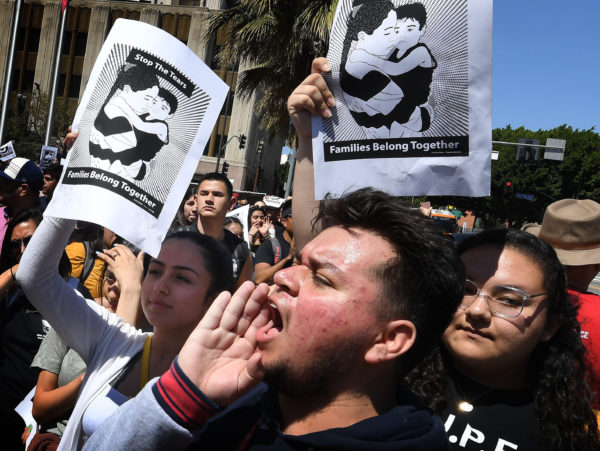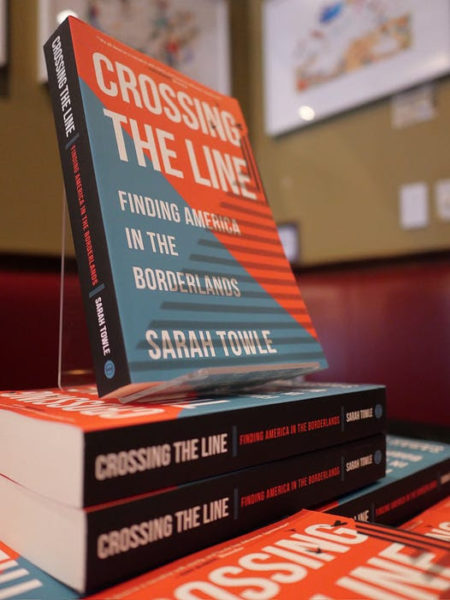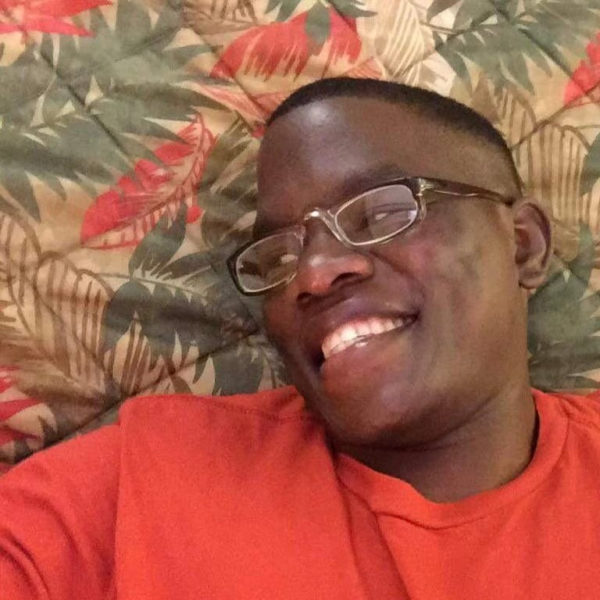The US-Mexico Border as a Many-Headed Hydra
A question and answer with author Sarah Towle

“The real crisis at the US southern border is not the people coming across, but the hardening of the human heart,” says the author of CROSSING THE LINE.
By Todd Miller (The Border Chronicle)
HAVANA TIMES – As with many, educator, researcher, and writer Sarah Towle’s awareness about border issues substantially shifted during the Donald Trump presidency and the horrors of family separation. But for her, this awareness did not lessen with the election of Joe Biden in 2020. Instead, she hit the road to interview more than 100 people along the 2,000-mile U.S.-Mexico border. In doing so, she found out that family separation hadn’t really stopped. The result was the book Crossing the Line: Finding America in the Borderlands, published in June with perfect preelection timing.
One of the people she interviewed was Ugandan pastor Steven Tendo, who was the first to alert Towle to the WRAP, a repressive restraint device designed to immobilize people during deportation proceedings. Towle discusses this as well as why she has shifted the terminology of the longtime U.S. border strategy from “prevention through deterrence” to “deterrence through cruelty.” She also gives her thoughts about the upcoming U.S. elections.
Towle asks, “The [deterrence] theory only ever asked one question: How do we stop them? When we should be asking, then as now, Why are so many people on the run?”

Crossing the Line: Finding America in the Borderlands is such a thorough book and covers so many aspects of the border. What was it that made you sit down and write it? As I ask this, I am also thinking of someone reading this who might think the border is only a minor issue, or not their problem. … Why should that person read your book?
It was Trump and co.’s serial inhumanity—from tearing families apart to metering the universal human right to asylum protection to forcing safety seekers into homelessness in cartel-controlled northern Mexico under the Migrant “protection” protocols—that propelled me on a journey across the 2,000-mile U.S.-Mexico border, resulting in my book Crossing the Line: Finding America in the Borderlands.
When I heard the cries of six-year-old Alison Jimena Valencia Madrid, begging a border official in the Ursula lockup to please call her auntie, reciting over and over through veils of tears the phone number she was made to memorize in a moment of panic while other children sobbed in the background, my heartbreak joined that of millions. I was ashamed not just of my country but of myself.
I’ve made a career of welcoming newcomers and aiding asylum seekers as an English language and literacy educator. I’ve taught across the age span in myriad classroom contexts, including under the trees in refugee settings, such as El Salvador during the U.S.-funded Dirty Wars. But I didn’t understand the depth of the “brokenness” of our immigration system until June 2018, when Alison Jimena’s cries were heard round the world.
Our collective outrage sent us immediately into the streets, marching under the banner “Families Belong Together” in 750 demonstrations across the globe. And on June 20, family separation was supposedly ended by the use of a presidential Sharpie.
But it never really ended. And it didn’t start with Trump and co.
In my journey across the line, I would document eight ways in which U.S. immigration policies and practices separate families—and have for decades across administrations on both sides of the aisle. But I didn’t know this in June 2018. I had so much to learn.
Once in the borderlands to bear witness to the inhumanity I thought Trump had wrought, I realized that the cruelty was not his alone but had been enabled by a border industrial complex that began right about the time of my birth and grew up alongside me, hiding in plain sight just outside my privileged view. I thought, Sarah, if you didn’t know about the many-headed hydra in our midst—someone who has worked with newcomers and refugees since the sanctuary movement of the 1980s—then lots of others don’t know as well.
That’s why I wrote the book: because I believe that when they do, they’ll be outraged too. And just as our collective indignation brought Trump and co.’s family separation to an end, it is going to take us all singing out loud and in one strong voice: This is not the nation we want to be. We are better than this!
You wrote about quite a few people in the book, so this might be difficult. But I wonder if you can name one of the striking and inspiring border characters you met and what stood out to you?
You’re right that it’s hard to choose just one as there are about 100 voices represented in the book. But let’s look at the example of Pastor Steven Tendo. This gentleman wears proof of the tortures he suffered on his body: severed fingers; scars from being burned by dripping, molten plastic; wounds on his wrists and genitals from being strung from a beam by bound hands with weights tied to his scrotum. Horrible punishments for the “crime” of registering voters and teaching young people about their human rights.

Yet a Texas-based immigration judge denied Steven’s petition for asylum protection more than once. And all the while, the good pastor’s human rights were routinely violated by ICE.
Throughout his multiyear imprisonment at the Port Isabel prison, Pastor Steven was denied both medication and a diet necessary to control his diabetes, leading to escalating comorbidities that also went untreated. When Steven survived a potentially fatal case of COVID while incarcerated, he lost all fear. “I’m either going to die under ICE or in Uganda,” he told me.
He spoke up and spoke out. He became so vocal that ICE tried to shut him up. In September 2020, ICE attempted to return him to the harms and horrors he fled. His legal team and advocates took his plight to Congress and managed to stop the deportation in the final hours.
Back at Port Isabel, Steven described to me what safety seekers are made to endure every day by ICE’s Enforcement and Removals Operations (ERO). He was the first to alert me to the agency practice of immobilizing people’s bodies in stress positions, using a restraint device called the WRAP.
He didn’t know it was called the WRAP at the time. But thanks to his bravery and rich retellings, I was able to identify the apparatus exploited by U.S. federal agents every day to force compliance on the many through the of the few—a blatant violation of the UN Convention against Torture.
Of course, it is campaign season right now, and we hear a lot about the border in the national news. Having spent a lot of time on the ground in the borderlands, what do you think of how the national news describes the border and its reality? And how would you describe it yourself to a national audience if you had just one minute?
I would tell them that the real crisis at the U.S. southern border is not the people coming across, but the hardening of the human heart.
The “border crisis” the national news media bang on about ad nauseam is manufactured—built on a single theory that has never, ever worked. Called “prevention through deterrence,” what I prefer to call “deterrence through cruelty,” it posits that if we make northward migration as dangerous and as difficult, as painful and as perilous as possible, those who survive it—and many don’t—will send word back home: Do not come. Do not Come.
Unleashed exactly 30 years ago, on October 1, 1994, under the name Operation Gatekeeper, “deterrence through cruelty” triggered the militarization of the U.S.-Mexico borderlands in response to U.S. State Department predictions that the North American Free Trade Agreement, enacted nine months before, would cause widespread human displacement, driving folks to seek refuge in El Norte.
The theory only ever asked one question: How do we stop them?
When we should be asking, then as now: Why are so many people on the run?
Last, what thoughts do you have leading into the election, and what do you hope happens on the border/in the borderlands as we move into the future?
My call to action is twofold: stop Trump and co., then use the lame-duck period to mobilize.
We cannot make the same mistake we did in 2020, which was to get a Democrat elected, then assume our work was done. Biden was no better on this issue than Trump. We can’t trust Harris to be either.
If we want to roll back the impunity of the border industrial complex, we must rise up in collective indignation—just as we did to stop family separation. We must raise our voices in glorious harmony to declare, ¡Basta! The cruelty is not OK!
So vote Blue up and down the ballot. And read my book. As you meet the many ordinary people expressing extraordinary acts of kindness every day—showing us that there is a better way, that we can welcome with dignity—take note of the example that makes your heart beat a little faster. Then choose to do that. And get to work.





